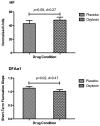Oxytocin increases heart rate variability in humans at rest: implications for social approach-related motivation and capacity for social engagement
- PMID: 22937145
- PMCID: PMC3429409
- DOI: 10.1371/journal.pone.0044014
Oxytocin increases heart rate variability in humans at rest: implications for social approach-related motivation and capacity for social engagement
Abstract
Context: Oxytocin (OT) plays a key regulatory role in human social behaviour. While prior studies have examined the effects of OT on observable social behaviours, studies have seldom examined the effects of OT on psychophysiological markers such as heart rate variability (HRV), which provides an index of individual's motivation for social behaviour. Furthermore, no studies have examined the impact of OT on HRV under resting conditions, which provides an index of maximal capacity for social engagement.
Objective: To examine the effects of OT on HRV measures in healthy male participants while at rest. OT was hypothesised to increase HRV, compared to placebo, and that the effects would be greatest for a non-linear measure of HRV (the detrended fluctuation scaling exponent).
Methods: Twenty-one male participants were recruited for this study. Participants were non-smokers, not on any medications and reported no history of psychiatric illness, neurological disorder, or any other serious medical condition (e.g. diabetes, cardiovascular disease). The study employed a randomised, placebo-controlled, within-subject, crossover, experimental design.
Main outcome measures: HRV was calculated from electrocardiography under a standardized, 10-minute, resting state condition.
Results: As hypothesised, OT increased HRV and these effects were largest using the detrended fluctuation scaling exponent, a non-linear measure. These changes were observed in the absence of any change in state mood, as measured by the profile of mood states. Importantly, participants were unable to correctly guess which treatment they had been assigned at either of the two assessments.
Conclusions: Together with the broader literature on OT and HRV, findings suggest that acute administration of OT may facilitate a fundamental psychophysiological feature of social behaviour, increasing capacity for social engagement. Findings also suggest that HRV changes may provide a novel biomarker of response to OT nasal spray that can be incorporated into research on response to treatment.
Conflict of interest statement
Figures


Similar articles
-
Effects of intranasal oxytocin on social anxiety in males with fragile X syndrome.Psychoneuroendocrinology. 2012 Apr;37(4):509-18. doi: 10.1016/j.psyneuen.2011.07.020. Epub 2011 Aug 20. Psychoneuroendocrinology. 2012. PMID: 21862226 Free PMC article. Clinical Trial.
-
Temporal profile of intranasal oxytocin in the human autonomic nervous system at rest: An electrocardiography and pupillometry study.J Psychopharmacol. 2023 Jun;37(6):566-576. doi: 10.1177/02698811231158233. Epub 2023 Mar 9. J Psychopharmacol. 2023. PMID: 36891949 Free PMC article. Clinical Trial.
-
Oxytocin administration to parent enhances infant physiological and behavioral readiness for social engagement.Biol Psychiatry. 2012 Dec 15;72(12):982-9. doi: 10.1016/j.biopsych.2012.06.011. Epub 2012 Jul 13. Biol Psychiatry. 2012. PMID: 22795645 Clinical Trial.
-
Oxytocin and Aggression.Curr Top Behav Neurosci. 2018;35:175-192. doi: 10.1007/7854_2017_13. Curr Top Behav Neurosci. 2018. PMID: 28864975 Review.
-
A general approach-avoidance hypothesis of oxytocin: accounting for social and non-social effects of oxytocin.Neurosci Biobehav Rev. 2014 Nov;47:506-19. doi: 10.1016/j.neubiorev.2014.10.007. Neurosci Biobehav Rev. 2014. PMID: 25454355 Review.
Cited by
-
What does Williams syndrome reveal about the determinants of social behavior?Front Hum Neurosci. 2013 Jun 28;7:321. doi: 10.3389/fnhum.2013.00321. Print 2013. Front Hum Neurosci. 2013. PMID: 23825455 Free PMC article.
-
The effect of intranasal oxytocin on the perception of affective touch and multisensory integration in anorexia nervosa: protocol for a double-blind placebo-controlled crossover study.BMJ Open. 2019 Mar 15;9(3):e024913. doi: 10.1136/bmjopen-2018-024913. BMJ Open. 2019. PMID: 30878983 Free PMC article.
-
Associations Between Nurse-Guided Variables and Plasma Oxytocin Trajectories in Premature Infants During Initial Hospitalization.Adv Neonatal Care. 2018 Feb;18(1):E12-E23. doi: 10.1097/ANC.0000000000000452. Adv Neonatal Care. 2018. PMID: 29337699 Free PMC article.
-
Development of precision medicine approaches to advance clinical trials for autism and social behavior: A research imperative.Proc Natl Acad Sci U S A. 2025 Jan 7;122(1):e2424066122. doi: 10.1073/pnas.2424066122. Epub 2024 Dec 30. Proc Natl Acad Sci U S A. 2025. PMID: 39793093 Free PMC article. No abstract available.
-
The impact of a single administration of intranasal oxytocin on the recognition of basic emotions in humans: a meta-analysis.Neuropsychopharmacology. 2013 Sep;38(10):1929-36. doi: 10.1038/npp.2013.86. Epub 2013 Apr 10. Neuropsychopharmacology. 2013. PMID: 23575742 Free PMC article. Review.
References
-
- Guastella AJ, MacLeod C (2012) A critical review of the influence of oxytocin nasal spray on social cognition in humans: Evidence and future directions. Hormones and Behavior: 1–39. doi: 10.1016/j.yhbeh.2012.01.002. - DOI - PubMed
-
- Kemp AH, Guastella AJ (2010) Oxytocin: prosocial behavior, social salience, or approach-related behavior? Biol Psychiatry 67: e33–e34; authorreplye35. doi: 10.1016/j.biopsych.2009.11.019. - DOI - PubMed
-
- Kemp AH, Guastella AJ (2011) The Role of Oxytocin in Human Affect: A Novel Hypothesis. Current Directions in Psychological Science 20: 222–231 doi: 10.1177/0963721411417547. - DOI
-
- Porges SW (2011) The Polyvagal Theory: Neurophysiological Foundations of Emotions, Attachment, Communication, and Self-regulation. 1st ed. New York: W. W. Norton & Company.
-
- Porges SW (2007) The polyvagal perspective. Biol Psychol 74: 116–143 doi: 10.1016/j.biopsycho.2006.06.009. - DOI - PMC - PubMed
Publication types
MeSH terms
Substances
LinkOut - more resources
Full Text Sources
Other Literature Sources
Research Materials

